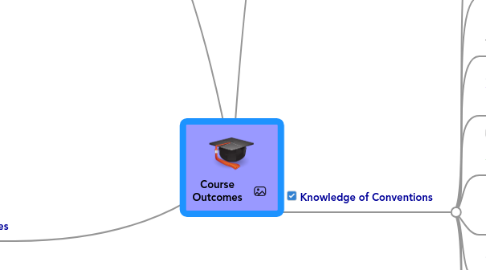Course Outcomes
by Victoria Burch


1. Processes
1.1. Be aware that it usually takes multiple drafts to create and complete a successful text
1.2. Develop flexible strategies for generating, revising, editing, and proof-reading
1.3. Determining the amount of required copyrighted material that is needed for developing a project should be part of the planning process.
1.4. Media and communication products (i.e., blog commentaries, educational media, social networks) are important raw data for communication research.
1.5. Understand the collaborative and social aspects of research and writing processes
1.6. One of the reasons people participate in online discussion groups is to share ideas with a group of "like-minded people"
1.7. Scholars quote copyrighted research results that can be published in journals, books, online and in media products.
1.8. Use appropriate technologies to manage data and information collected or generated for future use
1.9. Distinguish appropriate technology for specific audiences
2. Rhetorical Knowledge
2.1. Identify, articulate, and focus on a defined purpose
2.2. A focal point in web design can be enhanced with boldface, rules, colors and shape.
2.3. Respond to the need of the appropriate audience
2.4. Respond appropriately to different rhetorical situations
2.5. Use conventions of format and structure appropriate to the rhetorical situation
2.6. I would like to learn how to organize my thoughts and other sources of information with technology
2.7. When creating a layout for a webpage it is important to use proximity. You can do this by grouping related elements together.
2.8. Adopt appropriate voice, tone, and level of formality
2.9. the CRAP method will give your web page a level of sophistication and clarity to the viewer.
3. Knowledge of Conventions
3.1. Learn common formats for different genres
3.2. Scholars should use citations in a form & manner used in communication scholarship for material used in any publication of shared results of the study.
3.3. Develop knowledge of genre conventions ranging from structure and paragraphing to tone and mechanics
3.4. Learn how to write and format in multiple genres
3.5. CRAP method should be used as a basic layout design for webpages
3.6. Understand and apply legal and ethical uses of information and technology including copyright and intellectual property
3.7. I would like to obtain a better understanding of copyright laws
3.8. Copyright = all rights reserved, protects copyright owners, notifies public of their ownership. Only copyright owner has the right to use their work. Must ask permission.
3.8.1. Works become copyrighted the moment they are created. Last for the lifespan of the owner +70 years
3.9. Fair use = the right to use copyrighted material without permission or payment under certain circumstances.
3.9.1. To be justified as fair, the social or cultural benefits must outweigh the cost of the copyright owner.
3.10. Creative Commons (cc) = free copyright license; specifies the parts of your copyright you are willing to share with the public. Refines your copyright. Allows for collaboration.
3.10.1. Public Domain = commons of info where nothing is owned and all is permited
